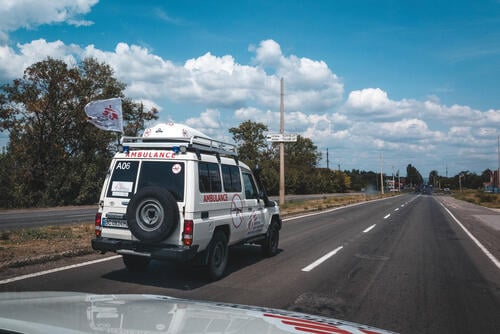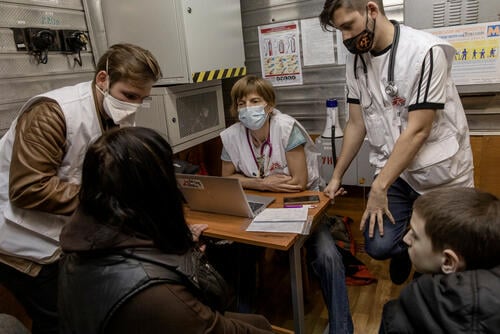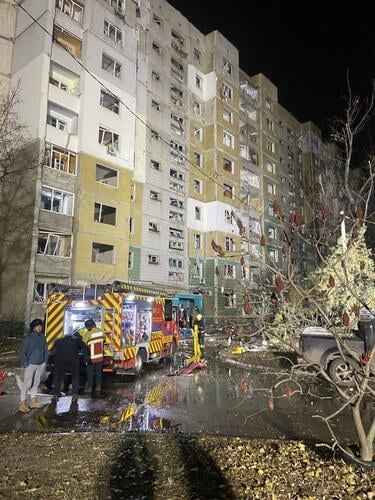A 45-year-old man, severely injured in shelling and suffering from burns to 90 percent of his body, waits for medical evacuation from a frontline hospital in the Donetsk region of eastern Ukraine.
“It’s insufferable,” he says. “Everything hurts. It’s hard to breathe; it burns everywhere.”
He requires specialised medical care, which is often only available in hospitals far from conflict areas. A Médecins Sans Frontières (MSF) ambulance is transporting him to the city of Dnipro, a medical hub where patients from the most dangerous regions receive treatment.
“MSF ambulances frequently transfer patients from frontline hospitals after surgery and initial medical care, but there are no guarantees that nothing will happen to them during transportation,” says Dmytro Bilous, a paramedic who has been working near the frontline with the MSF ambulance team.

“Bleeding may occur, and a patient’s condition can rapidly deteriorate from stable to unstable,” he says. “We carry the necessary medications to stabilise patients in such cases, or to apply a tourniquet and administer a haemostatic drug [to stop bleeding] if needed.”
Burns and other war-related injuries —head trauma, injuries to the torso and limbs, soft tissue damage, and massive haemorrhages— account for over 60 per cent of the cases our doctors encounter when transporting patients. As of 31 July 2024, the MSF ambulance team completed 8,000 patient referrals, with 15 per cent of these patients requiring transportation in intensive care unit ambulances. More than half of these injuries were directly caused by the ongoing full-scale war.
MSF medical teams have observed that medical facilities located 20 to 30 kilometres from conflict areas in eastern and southern Ukraine are either destroyed due to relentless shelling over the past two years, or partially damaged. Those that remain functional face a critical shortage of medical personnel. Since the full-scale invasion began in February 2022, many specialists have fled to safer cities or abroad.
Hospitals also suffer from a shortage of beds, as they are inundated not only with war-wounded patients but also with people suffering from chronic illnesses, heart attacks, strokes, and car accident injuries. By transporting patients to other hospitals, our teams support in alleviating the burden on hospitals close to conflict areas. The need for medical transportation by ambulance becomes especially acute during heavy missile attacks, when hospitals are overwhelmed by mass casualties.
“As a result of an attack in Kostiantynivka, Donetsk region, on 9 August, 14 people were killed, and over 40 were injured,” says Christopher Stokes, MSF’s emergency coordinator in Ukraine. “A supermarket and a post office in the city centre, where many civilians were present, were hit. There were dozens of wounded. MSF doctors assisted with wound care and suturing, and we also transported two severely injured patients to Dnipro using MSF ambulances.”
“With a constant influx of trauma patients needing referrals, MSF ambulance teams ensure that patients are transferred to hospitals where they can receive the specialised care they require,” he says.

How many intensive care or surgical beds will be needed in any given hospital is unpredictable. Shelling can occur at any moment, and our teams operate in a state of constant emergency. There have been cases where war-wounded patients had to be evacuated under fire, yet the medics continue to fulfil their duty.
“I have a child. He gets upset when I leave, asking, ‘You’re coming back, right?’” says Bilous. “I always tell him, ‘Yes, of course, I will come back’. I have to work so that he grows up without witnessing all of this.”
MSF ambulances began conducting medical referrals in Ukraine in April 2022. Today, the fleet consists of 17 vehicles, supported by 36 paramedics, 8 doctors, and 26 drivers, all of whom work tirelessly to ensure proper care. Additionally, logisticians, pharmacists, and coordinators ensure the effective operation of the project.
Bilous says that they often ask civilians why they continue to live near the frontline despite the danger. ‘We just didn’t have time to evacuate’ is the most common response.
According to estimates, approximately one million people in Ukraine continue to live close to the conflict areas.https://www.telegraph.co.uk/global-health/terror-and-security/bohorodychne-ukraine-russia-war-villages/ They cling to the homes they have built over their lifetimes, to familiar streets, gardens, flowers, and trees that, despite the war, still bear fruit. These people hold on to the hope for peace.






